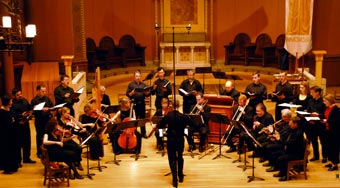Yesterday night, the First Church of Cambridge was the home of the renaissance choir Blue Heron. Under the direction of Scott Metcalfe, the Blue Heron presented secular and sacred music from the Peterhouse partbooks (copied for the Canterbury Cathedral in the first half of the 16th century and named after their current home at Peterhouse College in Cambridge, England), from the Fayrfax Manuscript and from Henry VIII’s Manuscript. Since its foundation in 1999 the Blue Heron ensemble devotes itself to the study and performance of 15th-century English and Franco-Flemish polyphony, with a special interest in the still unexplored repertory of the Peterhouse partbooks, which together with secular songs from the other two Tudorian sources formed a large part of yesterday evening’s program.
The rich musical corpus of the Peterhouse manuscripts contains seventy-two works, for many of which the Peterhouse manuscript is the only available source of transmission. As one of the few extant sources of pre-Reformation England, the Peterhouse partbooks pass on an important repertory of Masses, Magnificats, and votive antiphons to our generation. They contain music by known as well as lesser known and unknown composers, such as Thomas Tallis, John Taverner, Hugh Aston, Robert Jones, among others.
While the Peterhouse partbooks evaded demolition during the Tudor period, they still suffered from considerable loss. By lacking the tenor partbook as well as some pages from the discantus part, this body of music lost one of its arms so to speak. If substantial parts were missing in the sources how could a concert with this music take place? Blue Heron’s performance was based on the reconstructions of the missing parts by the British musicologist Nick Sandon [1] These reconstructions were done in such a masterful and natural manner that they could make the audience forget the contribution of a foreign hand.
The program of the concert was creatively designed to display diverse examples of both, tension and rest, sacred and secular songs. The dramatic atmosphere created at different moments of the program for instance with Tallis’ votive antiphon, Ave rosa sine spinis or the Magnificat by Robert Jones, was immediately followed by a section of playful songs from the Fayrfax and Henry VIII manuscripts. Blue Heron ended yesterday’s concert with a typical Tudorian antiphon glorifying the Virgin Mary, Ave Maria ancilla trinitatis by Hugh Aston. This Marian antiphon – probably in its first North American performance ever – was given a clearly audible form by Blue Heron’s mature interpretation that congenially supported the pieces climax with the Amen at the end.
References:
[1] Nick Sandon: “The Henrician partbooks belonging to Peterhouse, Cambridge (Cambridge, University Library, Peterhouse manuscripts 471-474): a study, with restorations of the incomplete compositions contained in them” (PhD diss., University of Exeter, 1983).





FYI, since this (wonderful) review appeared, the group have released two CD’s of Peterhouse partbooks music to critical acclaim, including attention from The New Yorker'(Alex Ross). Three more CD’s in the series are planned in the coming years.